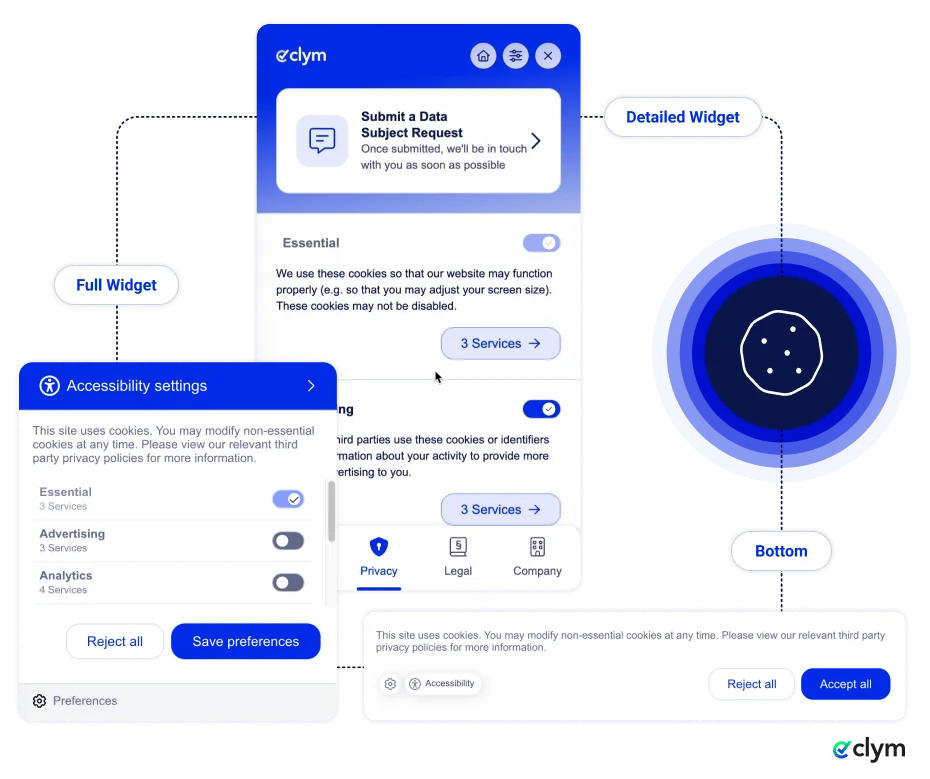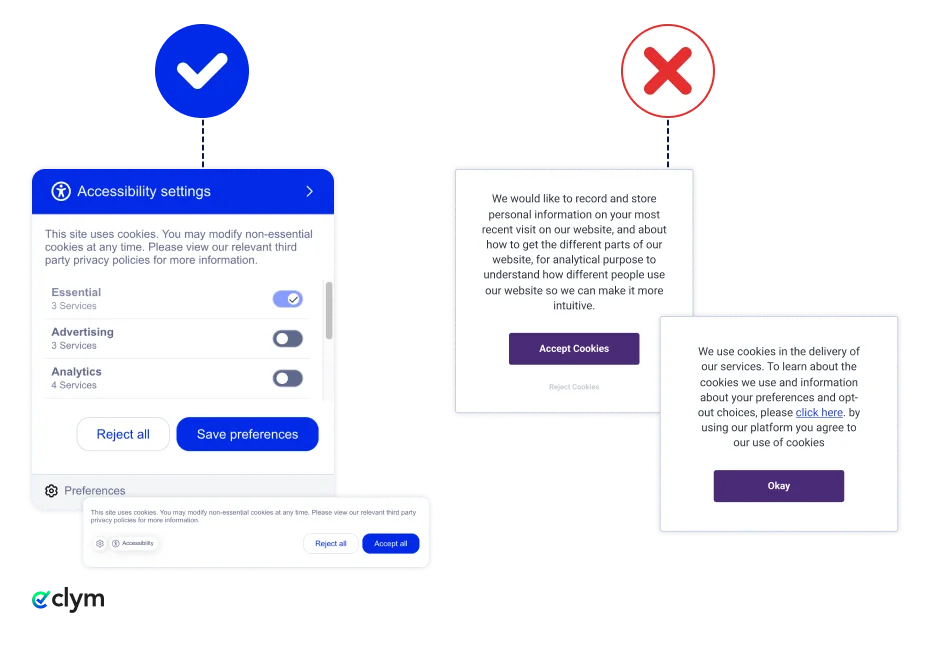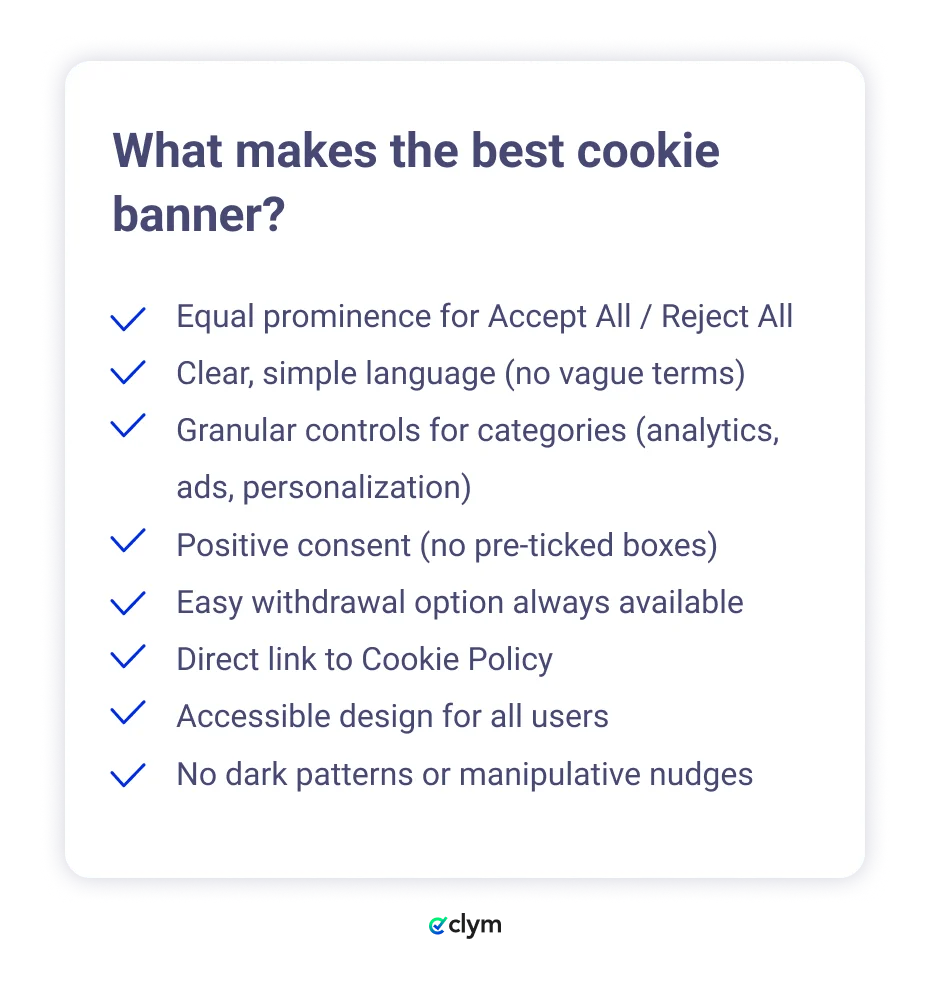Best Cookie Banner: Design, Requirements, and Why Businesses Choose Clym
Summary
Cookie banners are now a legal and business requirement under laws like GDPR, CCPA, and LGPD. The best ones go beyond compliance, improving trust, transparency, and conversions.
Effective banners give users clear options—equal “Accept All” and “Reject All” buttons, granular choices, and easy preference changes—without dark patterns. Clym’s Consent Management Platform supports 150+ global privacy and accessibility regulations and advanced consent types, including HIPAA, VPPA, Google Consent Mode v2, and IAB TCF. It helps organizations manage consent, privacy, and accessibility in one adaptable widget.
As privacy expectations and regulations evolve, flexible consent tools like Clym’s help businesses maintain transparency, respect user choices, and operate confidently across regions.
Why cookie banners matter for growth
Cookie consent banners are no longer optional. Under GDPR, CCPA, LGPD, and other privacy laws, businesses are expected to provide visitors with clear and fair consent choices. Poorly designed cookie banners increase risk and frustrate users. Well-designed banners support trust, reduce abandonment, and improve conversions.
The best cookie banner goes beyond regulatory requirements. It strengthens the user experience, reflects brand credibility, and supports marketing and analytics strategies.
What makes the best cookie banner
To align with global standards and user expectations, the most effective cookie banners include:
Equal prominence: “Accept All” and “Reject All” should be the same size to avoid bias.
Clear language: Use direct labels like “Accept All” and “Reject All.”
Granular control: Allow visitors to choose specific categories, such as analytics or advertising.
Positive consent: Non-essential cookies should activate only after a user opts in.
Easy withdrawal: Provide a visible “Change Preferences” option at all times.
Transparency: Link directly to a Cookie Policy or display and explain how cookies are used.
No dark patterns: Avoid manipulative designs that push users toward a single choice.
These features support stronger user experiences and facilitate higher engagement.
Cookie banner requirements by law
Law/Region | Consent model | Opt-in/Opt-out | Additional notes |
|---|---|---|---|
GDPR (EU) | Explicit consent for non-essential cookies | Opt-in | Granular choices required |
CCPA/CPRA (California) | Inform and provide “Do Not Sell or Share My Personal Information” option | Opt-out | Must be visible on every page |
LGPD (Brazil) | Free, informed, unambiguous consent | Opt-in | Similar to GDPR |
PIPEDA (Canada) | Meaningful consent required | Opt-in | Transparency emphasized |
POPIA (South Africa) | Explicit consent for processing | Opt-in | Applies to cookies that collect personal data |
Organizations with global visitors often need a solution that adapts automatically. Clym supports more than 150 data privacy and accessibility regulations, helping websites apply the correct model based on visitor location without adding friction.
Want to see how your website is doing?
Run a free cookie scan today!
Beyond cookies: advanced consent types
Modern compliance requires flexibility. Businesses often need more than a cookie banner to support user trust and regulatory expectations.
Clym provides consent solutions for multiple scenarios, including:
Standard cookie consent
HIPAA web tracking consent for healthcare data
VPPA consent for video privacy act
Wiretapping consent for states with live chat rules
IAB Transparency and Consent Framework (TCF)
Google Consent Mode v2 for digital advertising
Microsoft Consent for digital advertising
Global Privacy Controls (GPC) signals
Global Privacy Platform for cross-border requirements
By supporting these consent types in one widget, Clym facilitates consistent, user-friendly experiences across industries and jurisdictions.
Cookie banner design best practices
Placement: A footer banner or modal typically informs users without disrupting their visit.
Language: Clear, human text performs better than dense legal wording.
Brand alignment: Banner design should match the style of the website.
Accessibility: Banners need to work with assistive technologies. Clym includes built-in accessibility support to help businesses achieve this.

Examples of good vs bad cookie banners
Good cookie banner | Bad cookie banner |
|---|---|
Equal-size “Accept” and “Reject” | Small “Reject” button hidden in a corner |
Clear, simple language | Vague “Manage settings” with unclear choices |
Granular cookie categories | Only “Accept All” option available |
Links to Cookie Policy | No explanation of cookie use |
Organizations that adopt good design practices see stronger user trust and smoother interactions.

Why businesses are moving beyond basic cookie banners
Basic cookie banners are no longer enough in today’s complex privacy landscape. Modern businesses require solutions that can:
Adjust dynamically to regional laws through geo-targeting
Offer granular consent flows by category
Stay up to date with evolving global regulations
Support advanced ad tech frameworks like Google Consent Mode and IAB TCF
Remain fully accessible and on-brand across devices
More than just a cookie banner
Clym’s Consent Management Platform goes far beyond traditional banners. It’s part of an integrated compliance widget designed to help businesses manage consent, privacy, and accessibility, all within a single, centralized platform.
The platform is built around two core concepts:
Real-Time Compliance, which helps your website always be aligned with the latest legal and technical standards without manual intervention
Ready Compliance, which provides pre-configured templates and tools so you can facilitate complex requirements with minimal effort
Companies can easily adapt to over 150 global privacy laws, deliver localized multi-language consent experiences, and log user choices in an audit-ready format. Clym also supports key frameworks like Google Consent Mode v2, IAB TCF 2.2, and GPC signals, while allowing full design customization to reflect your brand.
From HIPAA and VPPA to wiretapping and state-specific laws, Clym enables businesses to scale privacy compliance without relying on fragmented point solutions. One platform. Full visibility. Global readiness.
Industries benefiting from smarter cookie banners
Healthcare: Healthcare organizations face strict privacy obligations under HIPAA, GDPR, and CCPA, particularly when web tracking involves personal health information. Clym supports providers by integrating HIPAA-specific consent flows into a unified banner experience that also reflects global privacy rules. This approach helps healthcare websites manage tracking and analytics responsibly while maintaining transparency and patient trust.
E-commerce: Online retailers must balance smooth shopping experiences with privacy expectations across diverse markets. Visitors may come from different U.S. states or across European countries, each governed by distinct data laws. Generic cookie banners risk interrupting the flow or triggering cart abandonment when they do not adapt to regional rules.
Clym helps e-commerce brands present consent options tailored by visitor location, showing only relevant disclosures and permissions. In addition, Clym integrates Google Consent Mode v2 automatically, sending refined consent signals (such as ad_user_data, ad_personalization, ad_storage, analytics_storage) to Google tools in real time. This approach helps merchants operate tracking and advertising scripts in a way that better aligns with user preferences and regional expectations, while preserving ad performance and clarity for shoppers.SaaS and technology: Global SaaS platforms often serve users across multiple jurisdictions, each with its own privacy requirements. Clym’s geo-targeted consent capabilities allow SaaS businesses to dynamically adjust banners based on the visitor’s location, presenting only the relevant regulatory content. This minimizes friction, avoids over-disclosure, and support compliance with more than 150 data privacy laws worldwide.
Media & publishing: Publishers and media companies rely heavily on advertising revenue, which makes consent a critical factor in maintaining both compliance and monetization. Clym supports IAB TCF 2.2, Google Consent Mode v2, and GPC (Global Privacy Control) signals, enabling publishers to balance ad performance with user privacy preferences. The result: a more transparent experience that strengthens trust while sustaining ad operations.
Checklist: What makes the best cookie banner?

The future of cookie banners
Privacy expectations and regulations are changing quickly, with new developments like the EU Digital Markets Act and an increasing number of state-level privacy laws in the United States. At the same time, the digital landscape is moving toward a cookieless future, where consent signals are becoming more important for advertising, analytics, and user experience.
Clym helps organizations navigate this shift by offering tools that adjust as regulations and technology evolve. Whether it’s adapting to new legal requirements or preparing for changes in how data is collected and used, the platform is designed to support long-term flexibility.
With Clym, you can implement a geo-aware cookie banner that responds to over 150 global regulations and offers support for advanced consent types like HIPAA, VPPA, and Google Consent Mode v2. You can also manage consent, privacy, and accessibility settings from one place, without relying on multiple disconnected tools.
If you’re exploring solutions in this space, feel free to take a closer look:
FAQs
A cookie consent banner is a small notice that appears on websites when users first visit. It explains what cookies are being used and allows visitors to accept, reject, or customize their preferences.
- Essential cookies: Required for basic functionality (no consent needed).
- Non-essential cookies: Analytics, advertising, and personalization (consent required under laws such as GDPR).
For a deeper explanation of cookies, see Understanding Cookies Part 1 and Part 2.
If your website collects personal or behavioral data through analytics, advertising, or tracking technologies, displaying a cookie banner helps give visitors control over their data choices. Regulations such as the GDPR, CCPA/CPRA, and PIPEDA expect websites to inform users and obtain valid consent before non-essential cookies are activated.
You can quickly check whether your site uses cookies that require consent by using Clym’s free Cookie Scanner. It analyzes your website, identifies active cookies, and provides a compliance score so you can understand what type of consent banner setting your website may need for each country.
Yes. The GDPR applies to organizations that offer goods or services to, or monitor the behavior of, people within the EU, regardless of where the organization is located. If your website attracts visitors from the EU, a geo-targeted cookie banner helps you apply the right consent model automatically.
Not all cookies need consent. Essential cookies, such as those that support website functionality or security, can usually run without user approval. Non-essential cookies, including analytics, advertising, and personalization cookies, typically require the visitor’s consent before activation. Using a solution like Clym’s Consent Management Platform helps you categorize cookies accurately and apply the right consent rules for each type.
Yes. The UK GDPR and the Privacy and Electronic Communications Regulations (PECR) expect websites to give users clear cookie choices. A banner that allows acceptance, rejection, or customization of cookies supports user control and helps you adapt to the UK’s consent standards. Clym’s geo-targeted consent tools automatically adjust banners to the visitor’s location, including the UK.
Most websites use cookies for analytics, personalization, or advertising. If any of these are not strictly necessary for your site’s functionality, you should use a cookie banner. To find out exactly which cookies your site sets, scan your website with Clym’s Cookie Scanner. It identifies all active cookies, classifies them, and shows whether consent is needed.
Yes. Google Analytics and advertising platforms use cookies that track user behavior and often require explicit consent depending on the visitor’s location. Clym integrates Google Consent Mode v2 automatically to send consent signals for analytics, ad personalization, and storage preferences, helping your tags operate in accordance with each user’s selected settings.
When configured correctly, a cookie banner records each visitor’s selection and blocks non-essential cookies until consent is given. Users can also revisit and modify their settings at any time. With Clym’s Consent Preference Center, visitors can easily review or change their consent choices, helping organizations maintain consistent, transparent practices.
Cookie banners inform users about the types of cookies in use and why they are being collected. They give visitors control over their privacy settings while supporting lawful data collection for analytics and marketing. By implementing a customizable cookie banner, businesses can demonstrate transparency and build trust with their audiences.
Many websites unintentionally create privacy and user experience issues through misconfigured or outdated cookie banners. Some of the most common mistakes include:
Using a single, global banner for all regions: Many websites display one generic cookie notice worldwide, instead of adapting to each country’s or state’s privacy requirements. Laws like the GDPR, CCPA/CPRA, and Quebec’s Law 25 require different consent models, and a one-size-fits-all approach can create both user confusion and regulatory risk. A geo-targeted solution like Clym’s Consent Management Platform automatically adjusts banners to local requirements.
Not showing which cookies and services are used: Transparency is key. Visitors should understand what types of cookies are active, which third-party services use them, and why they are being collected. Providing a detailed list of categories (analytics, advertising, functional, etc.) helps users make informed choices and builds trust.
Allowing scripts to fire before consent: A misconfigured banner or tag setup can result in tracking scripts activating before the visitor has provided permission. This undermines the purpose of consent management and can lead to unwanted data collection. Configurable platforms like Clym’s Consent Management Platform help control script behavior so that non-essential cookies activate only after valid consent has been recorded.
Using cookie walls or blockers: Some websites block access entirely until users accept or reject cookies. Regulators in regions like the EU have raised concerns about this approach, as it may pressure users into consent. It’s better to offer granular options that allow visitors to browse while managing their preferences freely.